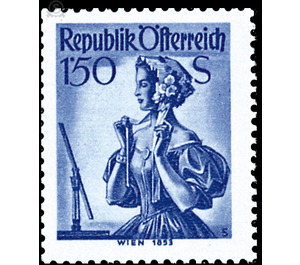strive - Austria / II. Republic of Austria 1951 - 1.50 Shilling
Theme: Devices, Items & Instruments
| Country | Austria / II. Republic of Austria |
| Issue Date | 1951 |
| Face Value | 1.50 |
| Color | blue |
| Printing Type | Photogravure |
| Stamp Type | Definitive |
| Item Type | Stamp |
| Chronological Issue Number | 259 |
| Chronological Chapter | OOS-OE2 |
| SID | 919858 |
| In 139 Wishlists | |
The girls' and women's costumes of Austria are shown as variations on that main piece of clothing that has been customary here since the high Middle Ages as a tuxedo and has only participated in temporal and fashionable transformations, but has retained its basic form. His basic motive is the loyal formention of the upper body and the free circulation of the abdomen and the legs, as it is still expressed in today's "Dirndl dress". In many landscapes, the baroque fashion suit, which has brought the bodice in its many forms, recognizable. The upper body is doing stronger, far from nature, wrapped, but emphasized its center. The only counterpart of the dress costumes is the Juppentracht of the Bregenzerwald, which is not taken at the waist, but adapted only by the Gürtung. How this characteristic garb is separated in its main part from the other Austrian women's costumes, so also in the Nebenstücke, in particular in the head costumes. The girl's crown, the "Schäppeli," is a pronounced maiden costume, as witnessed in the early Middle Ages. In the high alpine region, the women's headdresses consisted of fur covers and knotted woolen hats. Thus, both the basic forms of the costumes and all their accessories are constantly in the flow of the most diverse relationships between old-established domestic style and fashionable, time-related redesign. This interplay thus gives them their actual charm. The 1.50 S mark shows the costume from Vienna around 1853.


